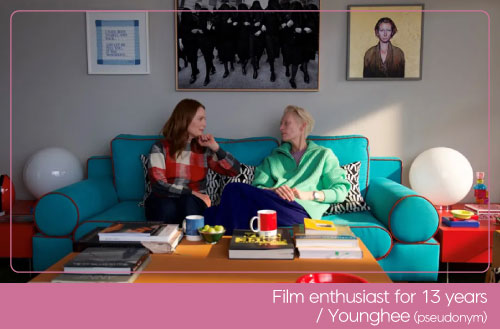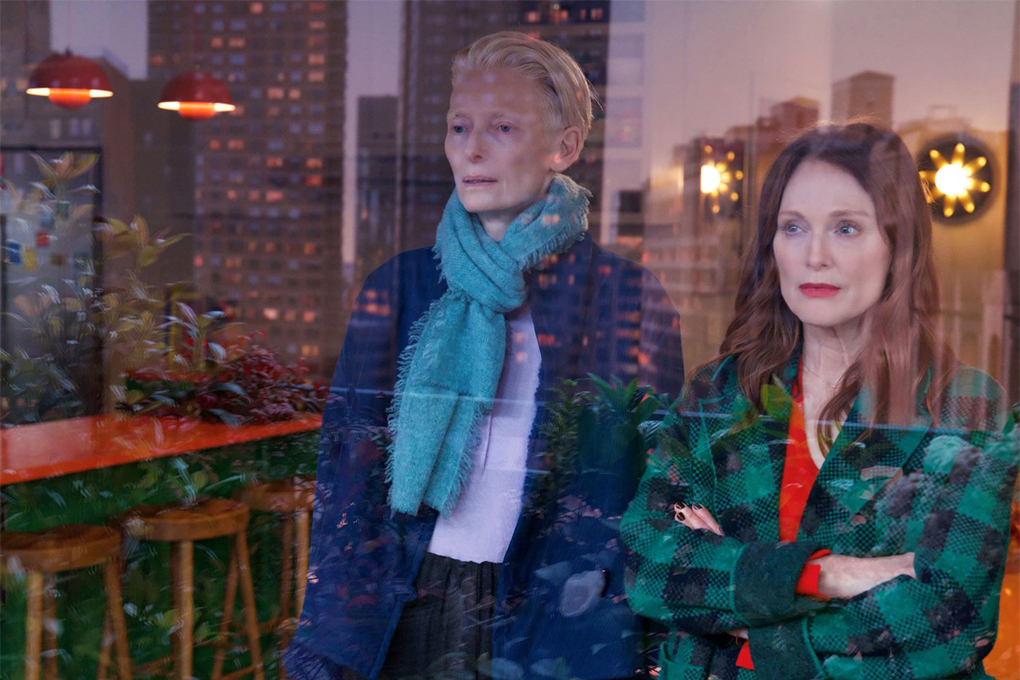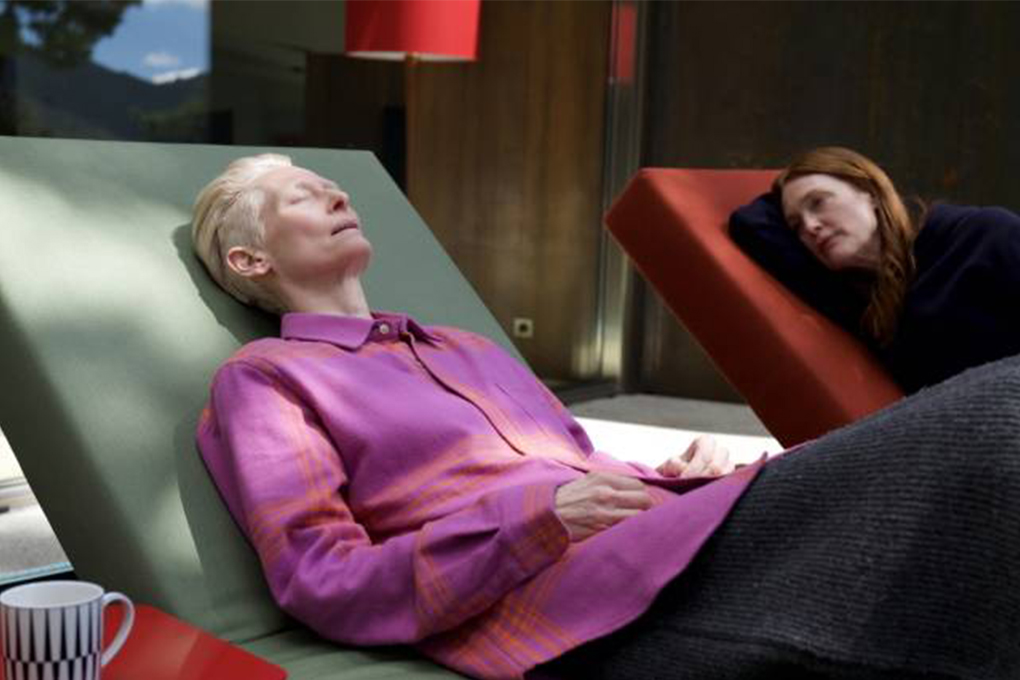


Columnist Younghee (Pseudonym)
Editor’s note
Cinema sometimes shows us realities that could easily unfold around us, and sometimes worlds we can barely reach. Through actors’ performances, we experience these worlds indirectly. In this column, I’ll introduce a dense film driven by a small cast while exploring both cinematic pleasure and insights into beauty.
※ Since this piece discusses key scenes essential to the film’s development and structure, I don’t recommend reading further for those sensitive to spoilers. Please note that interpretations related to the film are personal opinions.

Source: The Room Next Door poster (Source – Warner Bros. Korea)
#INTRO
The film I’m introducing today is “The Room Next Door,” which won the Golden Lion at the 81st Venice International Film Festival in 2024.
The Venice International Film Festival has a more open-minded approach compared to Cannes or Berlin, and it was the first among the world’s three major film festivals to award its top prize to an Asian film, Akira Kurosawa’s “Rashomon” in 1951. The festival also takes a flexible stance toward Netflix productions, awarding the Golden Lion to Alfonso Cuarón’s “Roma” in 2018. Venice’s winners typically tackle sharp social issues or challenge formal conventions.
“The Room Next Door” follows this tradition, tackling the potentially controversial subject of euthanasia and eliciting profound reflections on human dignity and beauty.
1 The Meaning of Staying Together

Source: The Room Next Door still (Source – Warner Bros. Korea)
“The Room Next Door” follows the quiet conversations between a woman preparing for the end of her life and another woman who chooses to stay by her side. The protagonist, Martha (Tilda Swinton), is a war correspondent who has witnessed the suffering and death of others up close throughout her career. After being diagnosed with stage 3 cervical cancer, she continues futile treatments in a New York hospice ward while trying to put her life in order. One day, writer Ingrid (Julianne Moore), who has come to New York to write about the climate crisis, learns about her former magazine colleague Martha’s situation and visits her in the hospital. Though they haven’t seen each other in years, their conversation quickly evolves into a deep curiosity and attraction surrounding life and choice.
Initially maintaining distance from each other, feelings of friendship and solidarity gradually bloom between them over time. Martha asks Ingrid, “When I die, could you be in the next room?” Though initially startled, Ingrid soon redefines herself as a companion who will stay by Martha’s side, and together they move to a rental house in the New York suburbs. This space—neither hospital nor hospice facility—is Martha’s personally chosen final setting, creating a warmer, more orderly tableau of life than any hospital room.
2 A Quiet Room, Emotions Like a Hopper Painting

Source: The Room Next Door still (Source – Warner Bros. Korea)
One of the most striking aspects of this film is its visual beauty, which remains despite tackling such heavy subject matter. Though set against life’s final chapter, the screen pulses with vitality and refinement, with spaces, costumes, and lighting delicately expressing the traces of a life lived. The clothes Martha and Ingrid wear, the props, and the entire space subtly modulate primary colors to evoke the energy of life.
Particularly moving is the scene where Martha applies makeup on her final day. As she applies red lipstick and quietly gazes at her own eyes in the mirror, her actions seem not like mere grooming but like a symbolic gesture of wanting to control her own destiny. This scene is precisely rendered through color, composition, and the flow of light, conveying emotion fully without exaggeration.

Edward Hopper, People in the sun, 1960.
Source: Smithsonian American Art Museum
Watching the film naturally brought Edward Hopper’s paintings to mind. Like Hopper’s works, where emotional afterimages flow through quiet, static compositions, this film utilizes spatial negative space to simultaneously reveal the characters’ isolation and solidarity, as well as their fear and tranquility. The director seems to have had this atmosphere in mind—indeed, Edward Hopper paintings hang in Martha’s rented space.
Though Martha initially appears detached, she seems to harbor a fear of uncontrolled death. Even amid this fear, her choice to dress, apply makeup, and decide how to leave represents an attitude focused not merely on death itself but on “how to depart” on her own terms. This approach actually becomes a way of living life more fully. Through Martha’s attitude, the film subtly conveys the process of coming to terms with the end and accepting it as a natural part of life.
3 If We Could Face Beauty’s End Together

Source: The Room Next Door still (Source – Warner Bros. Korea)
In the film’s latter half, a conversation between Ingrid and Martha’s old friend, a climate scientist, further expands the film’s emotional scope.
“When the end comes isn’t really what matters. What’s important is what we’re feeling right now as we move toward that end.”
His words overlay the fate of Earth as a vast entity with Martha as an individual, delivering the message that depth of emotion and attitude matter most when facing any form of disappearance. Climate crisis, death, human relationships, life’s conclusion—all of these are ultimately processes of ‘change’ and ‘transition.’ This film treats disappearance not as rupture but as organization, not as destruction but as circulation.
During her time staying by Martha’s side, Ingrid—an observer and writer—also comes to face her own feelings about life and death. Early in the film, Ingrid remains in the stance of trying to understand or explain death as a writer. She writes in her book’s preface that ‘writing about sudden death is work for the living,’ revealing her approach of trying to understand death only intellectually. Her hospital visit to Martha also initially stemmed from observation rather than emotion. But through Martha’s request and her conversation with the climate scientist, Ingrid gradually comes to accept death as ‘time spent together.’

Source: The Room Next Door still (Source – Warner Bros. Korea)
We usually don’t imagine the end when we look at something beautiful. Reflecting on endings can leave us feeling confused or anxious. However, this film suggests that the moment we look directly at that end, life actually becomes clearer. Martha’s room isn’t simply a place of farewell but an extension of life where all the sensations she’s lived with remain until the very end. Perhaps being conscious of and preparing for life’s end isn’t about giving up on life, but rather about seeing this present time more clearly.
If we could face beauty’s end together, wouldn’t that beauty approach us much more deeply and broadly? Life ultimately becomes richer and more precious under the premise that it has an end. The same goes for beauty. Perhaps it shines more brilliantly because it has an end.

#OUTRO
Sustainable Beauty Begins with Attitude
The attitude of this film—contemplating how to face life and what to leave behind—ultimately poses fundamental questions about ‘sustainability.’ It prompts us to consider not only the prospect of life’s final moments, but also the values and attitudes that might enable us to continue living meaningfully through our daily choices.
Amorepacific considers the sustainability of people, the environment, and beauty in accordance with these values. We continue various ESG activities and campaigns to share perspectives that look more deeply at beauty in daily life. I’ll close this column with the hope that sustainable beauty will spread more widely throughout our lives.
✍ The Room Next Door one-line review: When we face the end together, beauty becomes all the more profound.
 |

Younghee (pseudonym) |
|
|
Amorepacific
|
|
-
Like
0 -
Recommend
0 -
Thumbs up
0 -
Supporting
0 -
Want follow-up article
0





